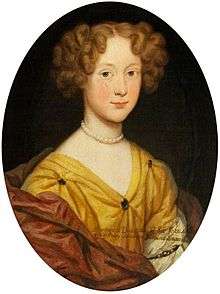John Talbot of Lacock
Sir John Talbot of Lacock Abbey, Wiltshire, Long Acre, Westminster, and Salwarpe, Worcestershire (7 June 1630 – 13 March 1714), was an English soldier, politician, and landowner, who sat in the House of Commons variously between 1660 and 1687. He was a second in a duel between George Villiers, 2nd Duke of Buckingham and Francis Talbot, 11th Earl of Shrewsbury.
Biography
Talbot was son of Sherington Talbot. He stood unsuccessfully for parliament at Worcestershire in 1659[1] and was elected Member of Parliament for Worcestershire in the Convention Parliament in 1660.[2] He was knighted by King Charles II at Whitehall on 6 June 1660[3] and became a Justice of the Peace for Worcestershire on 10 July 1660. He was commissioned as an ensign in the Company of Foot under Grey on 26 January 1661 and captain of a company of the Kings Own Regiment of Foot Guards in February 1661.[1][4] In 1661 he was elected a Member of Parliament for Knaresborough in the Cavalier Parliament and held the seat until 1679.[2] In January 1668 he was second for his kinsman Francis Talbot, 11th Earl of Shrewsbury in a duel with George Villiers, 2nd Duke of Buckingham in which the Earl was killed. According to Samuel Pepys, Talbot was also injured.[5] Talbot became lieutenant colonel of the Barbados Regiment of Dragoons on 30 March 1672 and served until 1674, when the regiment was disbanded. He was colonel of the Regiment of Dragoons from 22 February 1678 to 1679, when it was disbanded.[1]

Talbot was an elected Member of Parliament for Chippenham in February 1679 and sat until July.[2] He was elected a Member for Ludgershall in February 1681, holding the seat for one month.[2] In 1683 he was admitted an honorary freeman of Worcester. He was elected a member for Devizes in 1685 and sat until 1687.[2]
On the outbreak of the Monmouth rebellion in 1685, Talbot raised a troop of horse for King James II at Hounslow on 18 June 1685. He became colonel of horse on 21 September 1685 and camped with the King's army on Hounslow Heath on 30 June 1686. The troop was later disbanded and Talbot made lieutenant-colonel of the Earl of Peterborough's regiment (later 2nd Dragoon Guards). On 29 January 1687 he succeeded Lord Lumley as colonel of the Queen Dowager's Regiment of Horse (later 6th Dragoon Guards) and on the landing of the Prince of Orange was promoted brigadier general.[6] He resigned his command on 20 December 1688 and had no further military career.[1][6]
Talbot married firstly Elizabth Keyt, daughter of Sir John Keyt.[1] His second wife, whom he married in 1660, Barbara Slingsby (1633 - ?), daughter of Sir Henry Slingsby of Scriven, 1st Baronet and The Hon. Barbara Belasyse, by whom he had five children, was a matrilineal descendant of Cecily Neville, Duchess of York, and the mitochondrial DNA descent through which the remains of Richard III of England were identified in 2013 passes through her and their daughter Barbara Talbot (c. 1665 - 1763), who married in 1689 Henry Yelverton, 1st Viscount Longueville and 15th Baron Grey of Ruthyn, by whom she had seven children, and lived to the age of 98.[7]
He died at the age of 83.
References
- 1 2 3 4 5 W R Williams Parliamentary History of the County of Worcestershire
- 1 2 3 4 5 History of Parliament Online - Talbot, John
- ↑ William A. Shaw, The Knights of England, volume II (1906) page 227
- ↑ Dalton, Charles, ed. (1892). English Army Lists and Commisson Registers, 1661–1714. I 1661–1685. London: Eyre & Spottiswode. p. 7.
- ↑ Diary of Samuel Pepys, 17 January 1668
- 1 2 Richard Cannon, Historical Record of the Sixth Regiment of Dragoon Guards, or the Carabineers (1839) page 91
- ↑ http://www.le.ac.uk/richardiii/science/familytree.html
External links
- TALBOT, John (1630-1714), of Lacock Abbey, Wilts., Long Acre, Westminster and Salwarp, Worcs. at The History of Parliament online